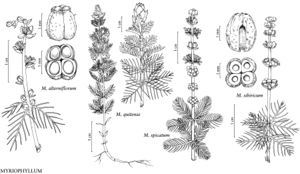Myriophyllum quitense
Nov. Gen. Sp. Pl. 6(fol.): 71; 6(qto.): 89. 1823.
Herbs monoecious, aquatic or semiaquatic, often forming dense stands. Stems often branched, to 3 m. Turions absent. Leaves mostly in whorls of (3 or)4(or 5), sometimes opposite to subopposite, heteromorphic; petiole 0–4 mm; submersed leaves pectinate to lobed (basalmost leaves opposite to subopposite, reduced, margins entire), ovate to obovate in outline, (3–)5–25(–35) × (2–)3–18(–20) mm, segments (2 or)3–9(–11), linear, ± applanate, longest segment (7–)8–15(–17) mm; emersed leaves pinnatisect to lobed or entire, ovate to oblong in outline, 2–9 × 1–6 mm, margins dentate to minutely serrate. Inflorescences to 8 cm; flowers proximally pistillate, medially bisexual, distally staminate; bracteoles cream, deltate, 0.5–1 × 0.2–0.6 mm, margins dentate to serrate, with glandular tip. Staminate flowers: sepals green to cream, ovate to deltate, (0.2–)0.3–0.5(–0.7) × (0.1–)0.2–0.4(–0.5) mm; petals persistent, ± purple, oblong, 2–3 × 0.5–1.5 mm; stamens 8, filaments to 0.6 mm, anthers 1.8–2.5 × 0.2–0.6 mm. Pistillate flowers: sepals cream, deltate, 0.2–0.5 × 0.1–0.4 mm; petals ± persistent, cream, ± cucullate, elliptic, 0.1–0.5 × 0.2–0.3 mm; pistils 1.1–2.2 mm, stigmas cream to ± purple, to 0.6 mm. Fruits cylindric to oblong, 4-lobed. Mericarps tan to olive-brown, cylindric to ovoid, 1.5–1.8 × 0.6–0.8 mm, transversely elliptic, abaxial surface rounded, smooth, sometimes with a shallow, longitudinal ridge, wings and ribs absent. 2n = 42.
Phenology: Flowering Jun–Aug.
Habitat: Cold oligotrophic waters, lakes, rivers, streams.
Elevation: 0–2800 m.
Distribution
B.C., N.B., P.E.I., Ariz., Calif., Idaho, Mont., Oreg., Utah, Wash., Wyo., s Mexico, South America.
Discussion
The most distinguishing feature of Myriophyllum quitense is the production of relatively large, ovate distal floral bracts with serrate margins. This characteristic is shared only with M. heterophyllum; however, M. quitense has eight stamens and the latter has four.
The proximal submersed leaves of most Myriophyllum species are uniformly pectinate, but those of M. quitense can range from entire or lobed to pectinate. This species often exhibits a pronounced transition from three or four proximal nodes of large, opposite, spatulate or lobed prophylls, to nodes of besomiform whorled leaves having obtriangular laminar surfaces and distal pinnatifid segments resembling those of pectinate leaves. In addition, the unusual grayish blue color of the foliage and whitish rhizomes are useful characteristics for distinguishing submersed vegetative specimens of M. quitense from similar species, such as M. sibiricum.
Myriophyllum quitense has a highly disjunct distribution in North America and South America (A. E. Orchard 1981; O. Ceska et al. 1986). S. G. Aiken (1981) and R. Couch and E. Nelson (1988) suggested that M. quitense was introduced into North America by migratory waterfowl. Both Ceska et al. and M. L. Moody and D. H. Les (2010) regarded it as native to North America. It has been reported from New Brunswick and Prince Edward Island (D. F. McAlpine et al. 2007) and further range extensions would seem likely given the level of disjunction in distribution.
Selected References
None.
